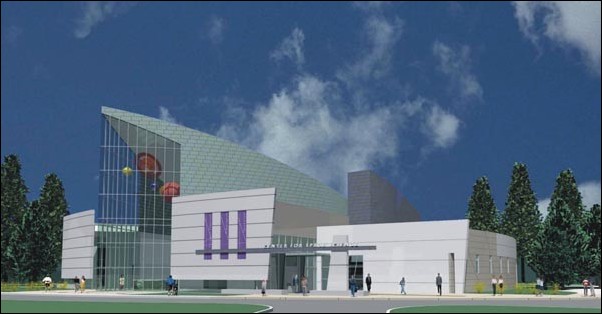$500,000 allocated for new Space Science Center
Image: $500,000 allocated for new Space Science Center:This conceptual drawing represents the completed Space Science Center, which is part of President Alexander Gonzalez’s Destination 2010. Courtesy of Public Affairs Office:
December 8, 2004
A proposed Space Science Center at Sacramento State received $500,000 in funding because of a Congressional Consolidated Appropriations Act in late November.
The new center, part of the Destination 2010 project proposed by President Alexander Gonzalez, will contain a planetarium, a new observatory and space for both classes and labs, said Marion O’Leary, dean of the College of Natural Sciences and Math.
Funding for the center, which will be located on the northeast side of campus, now totals $1 million. Including equipment, the building will cost an estimated $8 million.
Additional funding sources are still being sought out, with an eye toward trying to build the center within the next 18 to 24 months.
O’Leary said that the lack of a modern planetarium combined with the lack of a decent observatory for the highly active astronomy program at Sac State led to the idea to include a new observatory on campus and to combine that, along with space for both classes and labs, with the proposed planetarium.
“It started with a planetarium. And it started with the idea that essentially every major city in the United States has a nice state-of-the-art planetarium, except Sacramento,” O’Leary said. “The only planetarium here in town is a very small one (at the Discovery Museum Science and Space Center on Auburn Boulevard.)”
Another component of the center will be a hands-on exhibit for use by both school children and the general public.
“This hands-on science center will be a laboratory for groups that want to come in and do something together,” O’Leary said. “(The Space Science Center) won’t really be a classroom building, but it will have space for labs and such.”
While the planetarium, observatory and lab space will focus primarily on astronomy, the hands on component will include exhibits incorporating physics, chemistry, biology and engineering, as well as some exhibits including photos from previous NASA missions.
The Center for Mathematics and Science Education will also be housed in the center.
Although the center has received a major boost of funding, there are still major issues that need to be worked out, such as the rest of the funding of the building and the eventually staffing of the center. One proposed solution to any staffing problems that the center might have is to include student assistants in the new center.
“One of the best ways to learn about science is help teach it. So, we are going to need students to help us run this facility and science students in particular,” O’Leary said.
In addition, O’Leary said there might also be added faculty hired in conjunction with the construction of the center.
Much of the additional funding is expected to come from donations to the project.
“Ever since we started on this, we have been thinking about who the likely people and corporations are,” O’Leary said. “We have a very long list of candidates that we have talked to or will be talking too. We get a lot of enthusiasm when we go out and talk to people about this.”
The estates of late Sac State physics professors Chien Hu and Royal Vandenburg have donated $500,000, O’Leary said.
O’Leary added that part of the money from Hu’s estate has already been spent on a Foucault pendulum, which can be used to demonstrate the rotation of the earth, for the center.
Gary Shoemaker, chair of the Department of Physics and Astronomy, said those two donations will likely pay for the projector system that will go into the new planetarium, which could cost $500,000 or more.
“The projectors are very expensive, but they have multiple capabilities, so that in addition to astronomy programs, we could use it for other things,” Shoemaker said.
Shoemaker said that this center will likely lead to the expansion of the astronomy program.
“Next fall, for the first time in the history of the physics program, we will have two astronomers on the faulty at the same time. There will easily be work there for faculty to develop upper-division classes for the astronomy program. It is doubtful that we would ever have a full astronomy degree, but, in the short term, we could see a physics degree with an astrophysics concentration.”
Many of the science students on campus are excited about the new center.
“I think that’s it’s a good idea”, senior physics major Zhuo Huang said. “We will have a lot better facilities for the students to keep learning about nature and science. I think it will be really useful for future students.”







































































































































